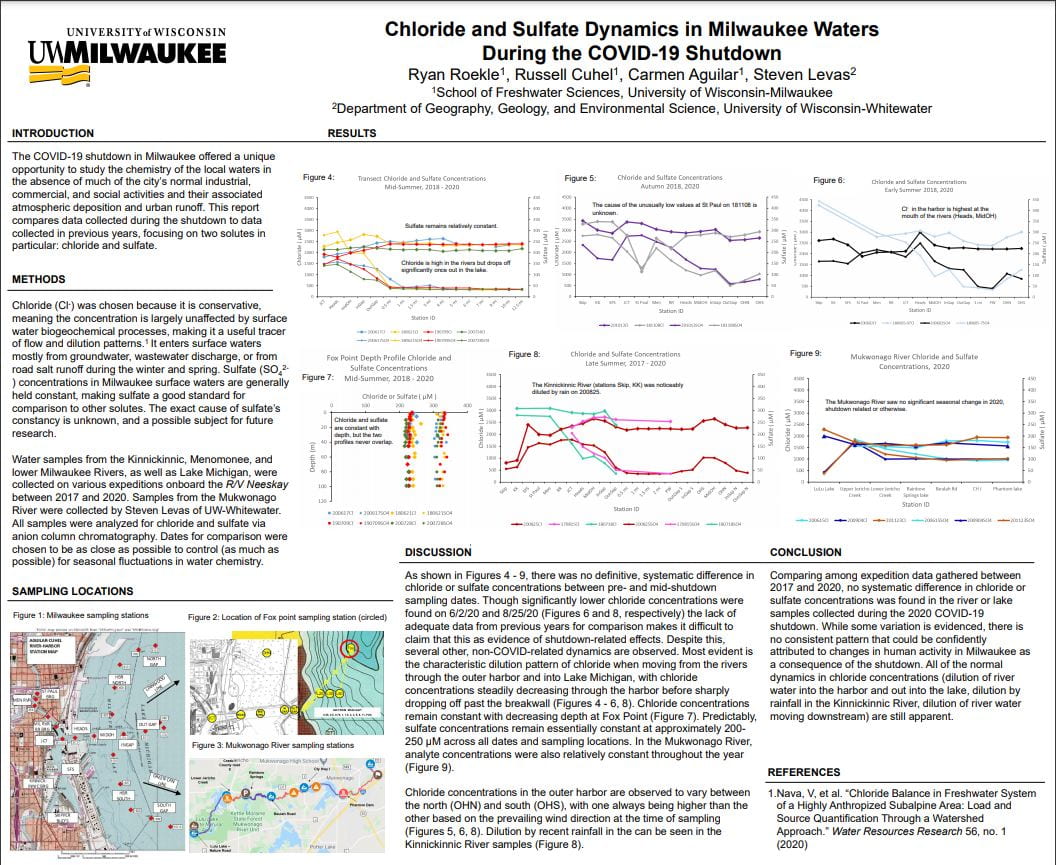Ryan Roekle, “Chloride and Sulfate Concentrations of Milwaukee Waters During the COVID-19 Shutdown”
Mentors: Russell Cuhel, Carmen Aguilar, and Steven Levas, Freshwater Sciences
Human activities in urban centers can alter the chemical composition of local waters via processes such as wastewater discharge and rainwater runoff. Rarely is there an opportunity to study urban waterways in the absence of these influences. The 2020 COVID-19 shutdown in Milwaukee, Wisconsin—a temporary, near total cessation of commercial, social, and industrial activities in the city— provided one such opportunity. Changes in local water chemistry were assessed among samples collected during early-shutdown, mid-shutdown, and late-shutdown (partial recovery) conditions. Here I focus on conservative chloride and semi-conservative sulfate concentrations. Analyses were carried out via automated anion column chromatography on water samples taken from locations along the Mukwonago, Menomonee, Kinnickinnic, and lower Milwaukee rivers, in the outer Milwaukee harbor, and up to 25 km offshore into Lake Michigan. Comparison of water chemistry between the different stages of the shutdown and to samples predating the shutdown may elucidate the extent to which urban activities affect local water chemistry. Sulfate concentrations are generally unaffected by local activity due to being held constant by biogeochemical influences. Chloride mostly originates from groundwater, which was unlikely to be affected by the shutdown. Chloride can also enter surface waters via urban runoff, which may have been affected by the shutdown, though road salt (a major source of chloride runoff) is not a factor during the summer. However, comparisons between pre- and mid-shutdown conditions (controlling for seasonal variation in water chemistry by comparing only between expeditions undertaken on similar dates) show no significant change in either chloride or sulfate concentrations due to the COVID-19 shutdown. Other, typical variations in chloride concentration—dilution of river water (5-fold or more) entering the lake, or surface dilution by recent rainfall—are still evident.
Click the thumbnail below to open the full sized poster in a new tab.

Great job! Surprised there was not more of a difference. Good idea and research during these unprecedented times.
Excellent work! Very clever to take advantage of the unique opportunity presented by the pandemic. How exciting would it have been to discover a significant effect from human activity? Nevertheless, disconfirming hypotheses, while lacking sex-appeal, is just as much the work of science as flashier discoveries.
Nice work, Ryan. I’d be interested to learn more about the specifics of the anion chromatography you did and the detection limits.
It seems to be that one of the dominant chloride signals would be road salt, and that that would not really have bene much affected by the pandemic. But there are actually very good stats on road salt use available and also on precipitation which would wash it off the roads), so some correlations could be tried.
John
Thank you, Dr. Berges! These studies spanned June through November, so road salt would not have been a player anymore.
Nicely presented Ryan!~ Was easy to follow and “place” spatially. The use of the rather unique circumstances of the past year was a good idea for investigating.
Ryan – your work is even more interpretable in your revised poster presentation. You have made good use of opportunity to learn a “marketable technique” AND gain insight into aquatic processes. Well done!